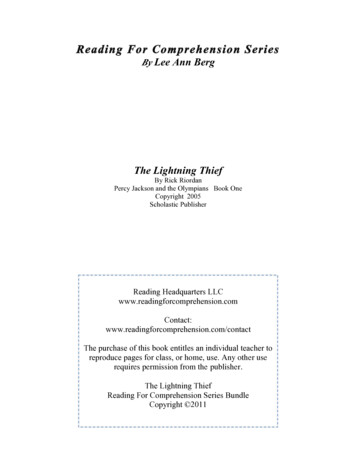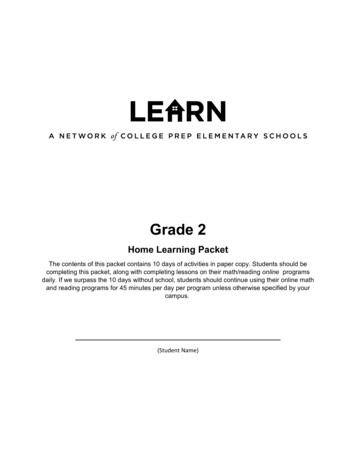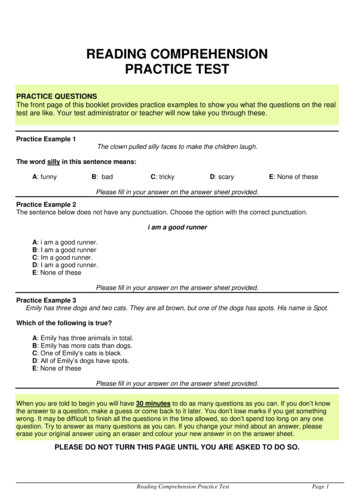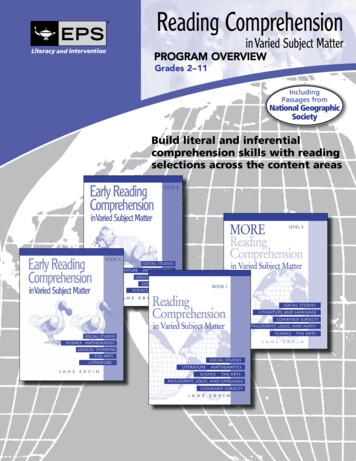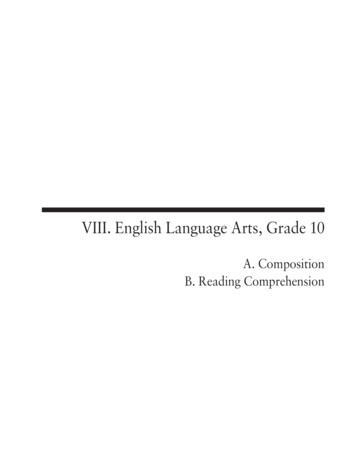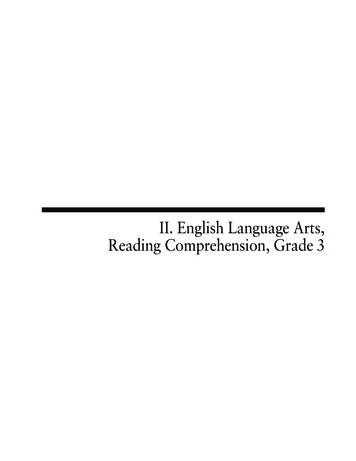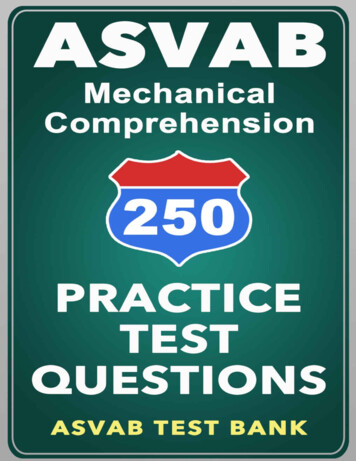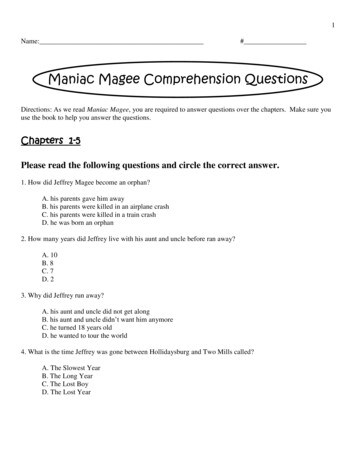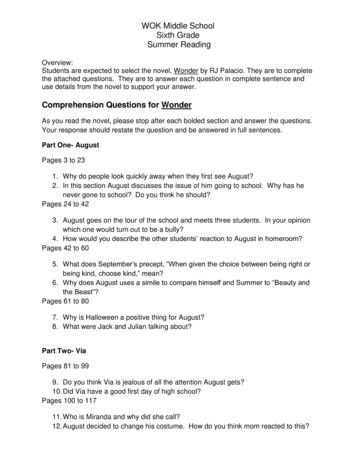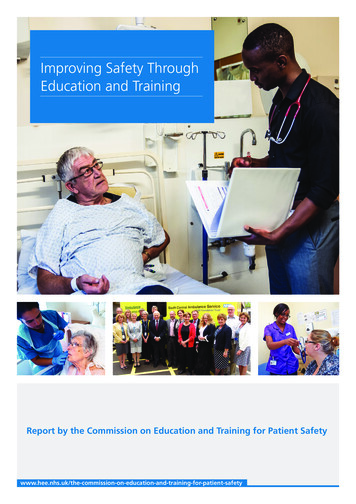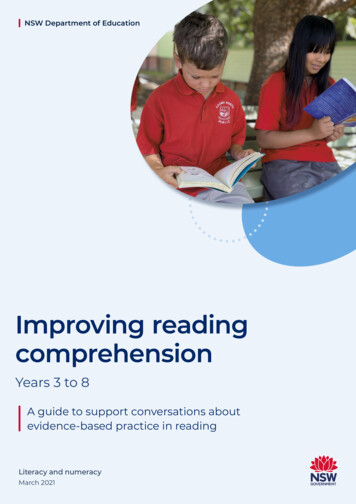
Transcription
NSW Department of EducationImproving readingcomprehensionYears 3 to 8A guide to support conversations aboutevidence‑based practice in readingLiteracy and numeracyMarch 2021
ContentsPurpose of the resource3Reading comprehension evidence base4Leading to improve reading6Phonological awareness and phonics8Fluency12Vocabulary15Reading comprehension19References24Hyperlinks25This document is designed for online use.Refer to page 25 for a list of full URLs for hyperlinked text if required.Improving reading comprehension – Years 3 to 82
Purpose of the resourceThe purpose of this guide is to support directors, educational leadership, principals,school leadership teams and teachers to have informed conversations aboutevidence-based reading instruction in all key learning areas across both primaryand secondary school contexts.This guide can: assist with an analysis of current practices help to inform planning for school improvement in reading suggest ways to build teacher capacity and understanding of effective readingwith explicit classroom practices and professional learning resources.Situational analysisThis guide can be used as part of the situational analysis in the following ways:Looking inward includes analysis of data, such asevidence of staff knowledge and perceptions aroundreading, and evidence of students’ current skillsin reading.The guide should be used in conjunction with athorough analysis of internal and external measuressuch as: Best Start Year 7 Assessment Check-in assessment NAPLAN data school-based data National Literacy Learning Progression EAL/D Learning Progression.Looking outward includes comparing the school’sapproach to the teaching of reading with the researchon effective reading instruction.This guide: explains the components of reading instruction describes evidence-based practices forreading instruction describes the roles and responsibilities ofall stakeholders.Looking forward includes making decisions inresponse to information gained in the Looking inwardand Looking outward phases.This guide makes suggestions for ways to adapt andimprove reading instruction across Years 3-8.Improving reading comprehension – Years 3 to 83
Reading comprehensionevidence baseReading is a complex cognitive process. It requires our brains to make newconnections between the parts that were designed to enable us to developoral language and process visual information. Learning to read requires explicitteaching in order for our brains to make those new connections.The Simple View of Reading (Gough and Tunmer, 1986) suggests that readingcomprehension is the product of two sets of skills: decoding and linguisticcomprehension. Since Gough and Tunmer’s original paper, many researchershave provided evidence that ‘measures of decoding and linguistic comprehensioneach predict reading comprehension and its development, and together the twocomponents account for almost all variance in this ability’ (Castles, Rastle andNation, 2018 p.27).The work of Hollis Scarborough (2001) further developed the Simple View ofReading through the use of a rope metaphor with strands of the rope representingthe various interconnected components of skilled reading (refer to imagebelow). This framework expands linguistic/language comprehension to includebackground knowledge, vocabulary knowledge, language structures, verbalreasoning and literacy knowledge. Scarborough also expanded the decoding/wordrecognition component of the Simple View of Reading to highlight the importanceof phonological awareness, decoding and sight recognition.Scarborough, H.S. (2001). Connecting early language and literacy to later reading (dis)abilities:Evidence, theory and practice. In S. Neuman & D. Dickson (Eds.), Handbook for research in earlyliteracy (pp. 97-110). New York, NY: Guilford Press.Improving reading comprehension – Years 3 to 84
Reading comprehension evidence baseLearn more about the reading rope with these videos: introduction to the reading rope upper strands of the reading rope lower strands of the reading rope.Reading researchers (as summarised in National Reading Panel, 2000, Rose, 2006and Rowe, 2005) agree that well-developed skills in both word recognition andlanguage comprehension are critical for skilled reading comprehension. Strengthin one area cannot compensate for a deficit in the other area. Scarboroughsuggests that skilled reading involves the ‘fluent execution and coordination ofword recognition and text comprehension’ (Scarborough, 2001).All teachers need a thorough understanding of how the complex cognitive processof reading develops, and how the many components work together as studentsread increasingly complex texts skilfully, strategically and critically. Reading isrequired for success in every subject area and so every teacher has a responsibilityto develop the general and subject, or discipline-specific, reading skills oftheir students.Text consideration across the curriculumIt is important to remember that even though students may have learnt to read ordecode with automaticity in the early years, they are still learning to read as theymove through primary school and into secondary school because they are beingfaced with content, concepts, texts and tasks that are increasingly demanding.They must continue to be explicitly taught to read in all curriculum areas.The Literacy K-12 Policy describes literacy as ‘the ability to understand and evaluatemeaning through reading and writing, listening and speaking, viewing andrepresenting.’ (NSW Literacy K-12 Policy, 1.1.1).As educators, it is essential to understand that ‘Teachers K-12, across all key learningareas, are responsible for the teaching and learning of literacy skills, knowledge andunderstandings.’ (NSW Literacy K-12 Policy, 1.2.6).This document includes advice for improving reading in Years 3-8. It is importantto note that teachers can differentiate the application of skills and strategiesaccording to stage of learning and complexity of texts.Improving reading comprehension – Years 3 to 85
Leading to improve readingPrincipals and leadership teams have a pivotal role in driving reading improvementin schools. This guide was developed to support conversations about readingimprovement in the context of school strategic planning.PrincipalTo drive improvement in reading, a Principal: ensures all staff have a consistent understanding of evidence-based instructionand assessment of reading promotes reading improvement as the shared responsibility of all staff in all keylearning areas leads a consistent school understanding of reading development using thesyllabus outcomes and the National Literacy Learning Progression indicators facilitates collaboration and collegial approaches to whole school readingimprovement, including through professional learning and strategies such asclassroom walk-throughs, collaborative planning and co-teaching ensures a consistent approach to data analysis and student progress monitoringin order to measure impact budgets for professional learning, the purchase of resources and interventionprograms for students who need further support with reading.Leadership teamTo drive improvement in reading, a leadership team: engages with ongoing research and evidence on the complex cognitive processof reading has a robust understanding of the components of reading and how they worktogether to achieve the ultimate goal of understanding texts reviews current literacy practices, teacher understanding and beliefs aboutreading, and available resources; this could include an evaluation of existingsubject-specific literacy teaching and learning, and the roles of staff such as theliteracy coordinator and literacy teams determines the similar requirements for reading across all subject disciplines.For example, across several subjects, students may need to recognise how acomposer brings authority to a text in order to evaluate the credibility of a text.These similarities can be used to inform targeted teaching and learning or as aspringboard for a whole-school approach to reading improvement establishes a consistent approach to the explicit and systematic teaching ofreading in all subject areas develops a shared responsibility and consistent use of language when discussingreading across the school provides opportunities for differentiated professional learning to strengthenteacher expertise in the explicit teaching of reading develops a consistent school understanding of reading development using thesyllabus outcomes and the National Literacy Learning ProgressionImproving reading comprehension – Years 3 to 86
Leading to improve reading establishes systems and structures to: ensure consistent and ongoing assessment of reading in all subject areas use data to make informed decisions about targeted interventions anddifferentiated reading instruction support collaborative strategies such as classroom observations, classroomwalk throughs and the analysis of work samples collaboratively plan for the explicit teaching of the components of readingthrough explicit practices such as modelled reading provide in-class support for explicit teaching of reading including co-teaching,observation of best practice and opportunities for feedback, reflection andcollaboration engage in reflective and evaluative conversations with colleagues support teachers to implement targeted interventions for students withidentified reading concerns ensure teachers are differentiating learning to cater for the needs of alllearners including EAL/D learners, students with disability and additionallearning and support needs, and high potential and gifted learners.Improving reading comprehension – Years 3 to 87
Phonological awareness and phonicsPhonological awarenessPhonological awareness is a critical skill for all students’ literacy development anda predictor of later reading and spelling success. Phonological awareness refers tooral language and is the understanding of the different ways that language can bebroken down into smaller parts.Phonological awareness development progresses from an understanding of thelarger units of sound, beginning with the subskills of word, syllable and onset/rime awareness, moving to the more complex subskills of basic and advancedphonemic awareness. Phonemic awareness is the most important phonologicalawareness skill and a prerequisite for learning the alphabetic or phonic code. Whena student can hear and say the separate phonemes in spoken words, they can thenrelate the phonemes to the graphemes that are used to represent them in writing.PhonicsPhonics is the relationship between printed letters and the sounds they representand is a vital component of learning to read. Phonics relies on phonemicawareness. The reader must understand that words are made up of phonemes orunits of sound. Phonics instruction connects these phonemes with written lettersso that the reader can transfer knowledge of sounds to the printed word. Studentsneed to learn to blend phonemes to read words. The goal of phonics instructionis to help readers quickly determine the sounds being represented in unfamiliarwritten words. When readers encounter new words in texts, they use their phonicknowledge to decode.Consideration for Years 3-8Phonological awareness and phonic knowledge are constrained skills thatare usually acquired in the early years of primary school. Students with strongphonological awareness and phonic knowledge are able to read words withautomaticity and with minimal conscious effort, meaning that cognitive resourcesare available for comprehension. Strong phonological awareness and phonicknowledge is also important for supporting automaticity in spelling.When a student is having difficulty with reading comprehension, it is important toinvestigate if there are phonological awareness and/or phonic knowledge concerns.Where concerns are identified, intervention may be needed to strengthen theseword recognition skills to the point of automaticity. Intervention measures mayinclude assistance from Learning and support (LaS) and English as an AdditionalLanguage/Dialect (EAL/D) teams. An EAL/D learner’s differing phonologicalawareness may arise from their English language proficiency level.Students in Years 3-8 will also continue to use their phonological awareness andphonic knowledge alongside morphological knowledge to spell with accuracyand automaticity.Improving reading comprehension – Years 3 to 88
Phonological awareness and phonicsSyllabus and progression linksNSW SyllabusNational Literacy Learning ProgressionAll teachers have a responsibility to supportstudents to develop the general anddiscipline-specific literacy requirements ofstudents in their curriculum area. Literacyis embedded throughout all K-10 syllabusdocuments as a general capability.The goal for these constrained skills, is thatstudents will have developed them by theend of Stage 1.The capabilities can be found in syllabusdocuments including:Phonic knowledge PkW8 mathematics science and technology historyPhonemic awareness PhA5Spelling SpG7 - SpG10 geography personal development, health andphysical education.The English learning area has a particular rolein developing literacy because of its inherentfocus on language and meaning.Stage 2: EN2-4A, EN2-5AStage 3: EN3-4AStage 4: EN4-3AImproving reading comprehension – Years 3 to 89
Phonological awareness and phonicsFurther supportProfessional learning availableAssessment tools and resources Effective Reading: Phonological AwarenesseLearning Phonemic awareness and the connectionto decoding video Effective Reading: Phonological Awareness(face-to-face) Phonemic awareness and the connectionto encoding video Effective reading: Phonics Phonological Awareness DiagnosticAssessment Focus on understanding texts: Thecomponents of reading – blended learningYears 3-8 Focus on creat
mathematics science and technology history geography personal development, health and physical education. The English learning area has a particular role in developing literacy because of its inherent focus on language and meaning. Stage 2: EN2-4A, EN2-5A Stage 3: EN3-4A Stage 4: EN4-3A The goal for these constrained skills, is that
